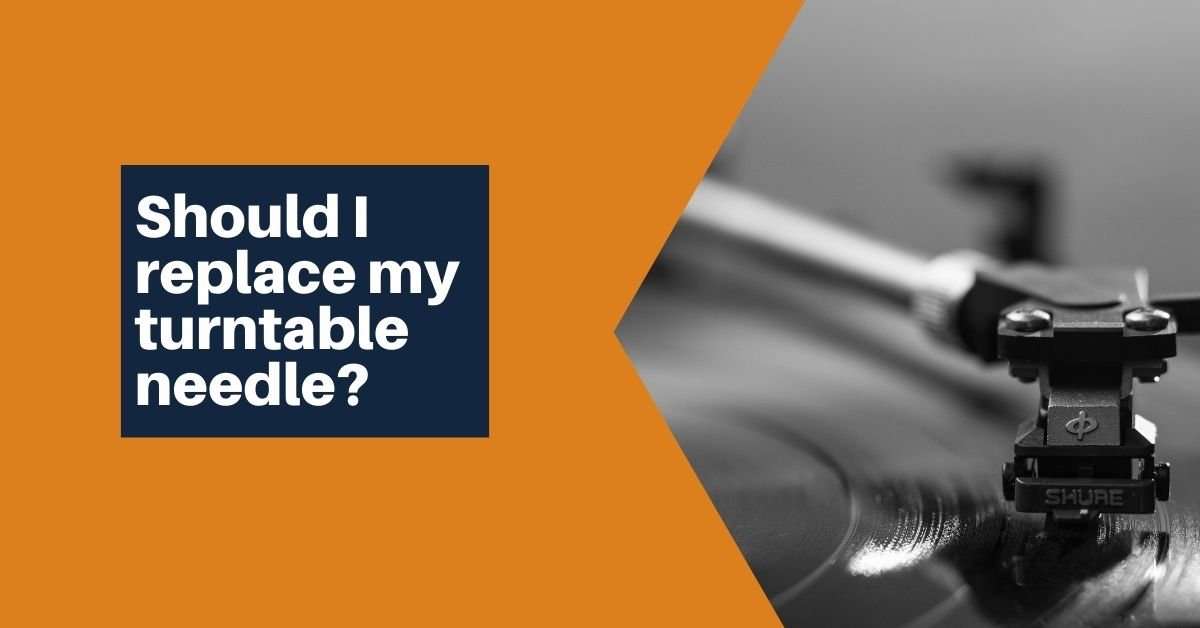Does something sound wrong with the sound quality of your turntable or record player? Maybe you’re hearing a great deal of distortion when playing your vinyl records.
While not all sounds of distortion are indicators that you may need to replace the stylus of your turntable, it is important to diagnose the issue as quickly as possible so as not to damage your records’ grooves.
Knowing how to tell if a turntable needle is bad is a fairly simple process and there are a variety of ways to figure out how.
How to Tell If a Turntable Needle is Bad
There are a few ways to diagnose a worn needle or turntable stylus. While testing, the experts at HiFi Hippo suggest using a clean, cheap record that you don’t mind potentially damaging.
Visible Damage to the Needle or Cartridge

Before anything else, make a visual inspection of the turntable needle, also called the stylus, for any noticeable wear and tear. A stylus can often pull up dust and dirt from the grooves of the record, especially if you’re listening to older pieces of vinyl.
If your music sounds distorted to muffled this could be a reason why. It should be fairly obvious when checking this as there will be a coagulation of dust on the point of the stylus.
Cleaning a Record Needle
If dirt and debris are present, you will probably not need to replace the stylus! In order to properly clean this, use a needle brush and brush your stylus forward to back (towards you) a couple of times. This should be enough to dislodge any unwanted debris.
If you don’t have a needle brush, an old toothbrush or with a steady hand can work. Just make sure you clean the brush beforehand.
Visually Inspecting a Turntable Needle for Signs of Damage
If no debris is present, inspect your turntable’s needle and cartridge. Is everything properly aligned and nothing is bent or looks wrong? The needle should appear sharp at its tip in order to properly track on a vinyl record.
If the tip is too dull, the point of the stylus will rub up against the walls of the groove and cause the audio to sound abrasive and sharp. Also, make sure all leads of your cartridge are properly connected.
What does a bad stylus sound like?
A bad stylus can cause your audio to sound distorted with heavy static and crackling during playback. This is because the stylus is unable to properly track the groove of the record, causing it to skip and produce an unpleasant sound.
Scratchy or Raspy Sounds
One obvious sign that can correlate with a needle that needs to be replaced is scratchy-sounding audio. This will be fairly easy to diagnose, and if you’ve set up your turntable correctly, can be an obvious sign a stylus replacement is needed.
It’s a good idea to always replace at least your needle if you’ve purchased a used turntable. After many hours of use, the stylus cantilever will lose its springy rebound. this has a noticeable effect on the playback quality while listening to records.
Thin Sounding Records
While you may not be hearing an obvious scratchy sound while playing your records, your music could sound slightly thin or lacking bass when played. As cartridges and needles wear and need replacing, you will notice this.
Make sure your EQ settings are dialed in normally. If you hear a lack of bass and treble, that could be an indicator of a worn needle that needs a replacement.
Reasons Why You Should Replace a Worn Stylus

Damage to records: A damaged stylus on a record player or turntable can damage your records and decrease the lifespan they can be played.
Improved sound quality: replacing your stylus when it’s needed will noticeably improve your sound quality performance.
Fix skipping: If your vinyl skips often with no visible signs of wear, it’s time to replace the stylus.
Upgrade old equipment: Even if everything seems fine, if you’ve purchased a second-hand turntable or record player and you don’t know the life of the stylus, it’s a good idea to have it replaced so you know when it was done and you’re ready to listen for hours to come!
Other Factors that Affect Sound Quality
Imbalanced Turntable Tonearm
Another factor that can affect the audio coming out of your speakers is your turntable tonearm balancing. While not as important for a record player, the turntable arm needs to be precisely balanced in order to properly replicate the sound from the record.
Don’t know which you have, read our article on turntables vs. record players.
Here’s a video on how to properly balance a tonearm
Electrical Grounding Issue
Another issue to look into would be to ensure your turntable and stereo head unit are properly grounded and all speaker wires and electrical connections are clean and making proper contact.
Typically, you will hear more of an electrical buzz, but it can be similar.
Damaged Speakers
Speakers that are old or damaged can create scratchy audio across your whole vinyl collection as you play it.
Replacing a Stylus on a Record Player or Turntable
If you’ve determined that your needle needs to be replaced, the process is fairly simple. You may need some basic tools and a little patience.
Depending on if you’re replacing just the needle or the whole cartridge, the process will be different. We have a few resources that can help.
For replacing a turntable cartridge, check out our guide here.
For record player needle replacement, you can find that guide here.
Enjoying a Replaced Stylus
Now that you’ve replaced your stylus, you’re turntable’s ready to go for many hours. It’s estimated that the lifespan of new needles is around 1,000 hours of listening time before needing to be replaced again. The key thing to remember is that before you replace your needle or cartridge, test all variables to ensure your fixing the right component.

Lead Editor / Owner
After beginning his career in the video and audio recording industry, Andrew started HiFi Hippo to share his knowledge and passion for vinyl and vintage audio with other readers.
